Abstract
The carcinogenic properties of selected metals and their compounds are reviewed to provide a useful reference for existing knowledge on relationships between physical and chemical forms, kinetics and carcinogenic potential and between epidemiology, bioassays, and short-term tests. Extensive consideration is given to arsenic, beryllium, cadmium, chromium, lead, and nickel. Other metals such as antimony, cobalt, copper, iron, manganese, selenium, and zinc are discussed briefly.
Full text
PDF

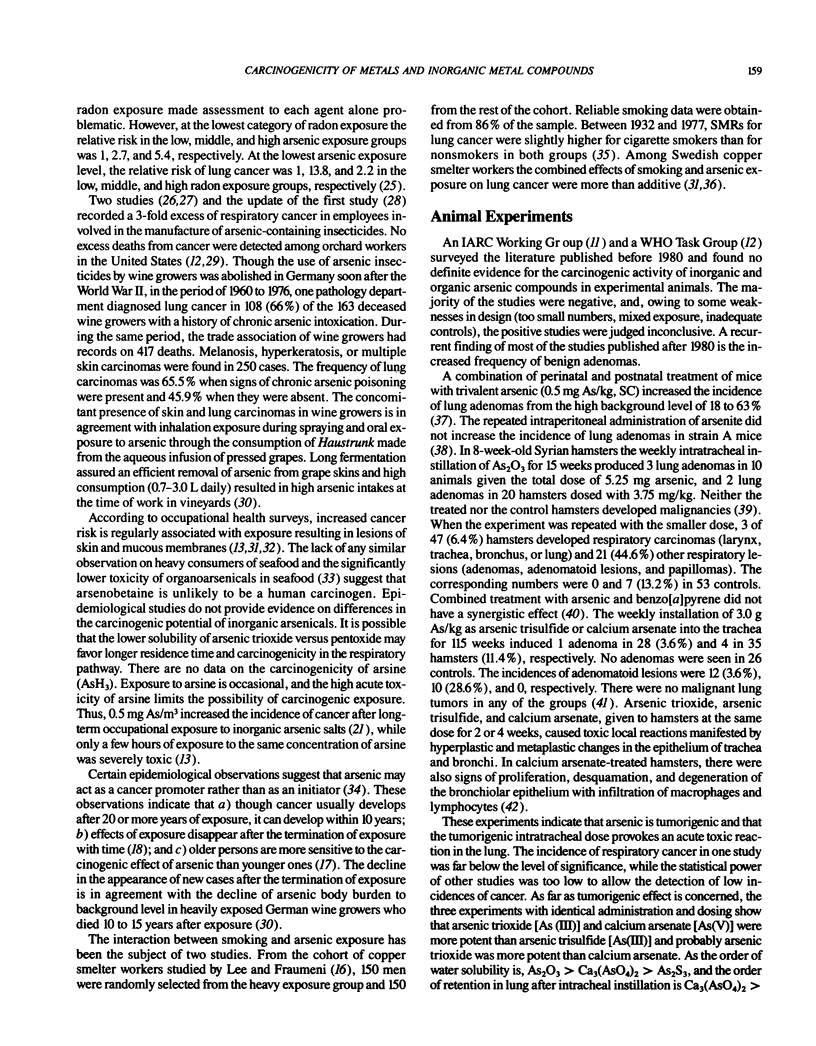





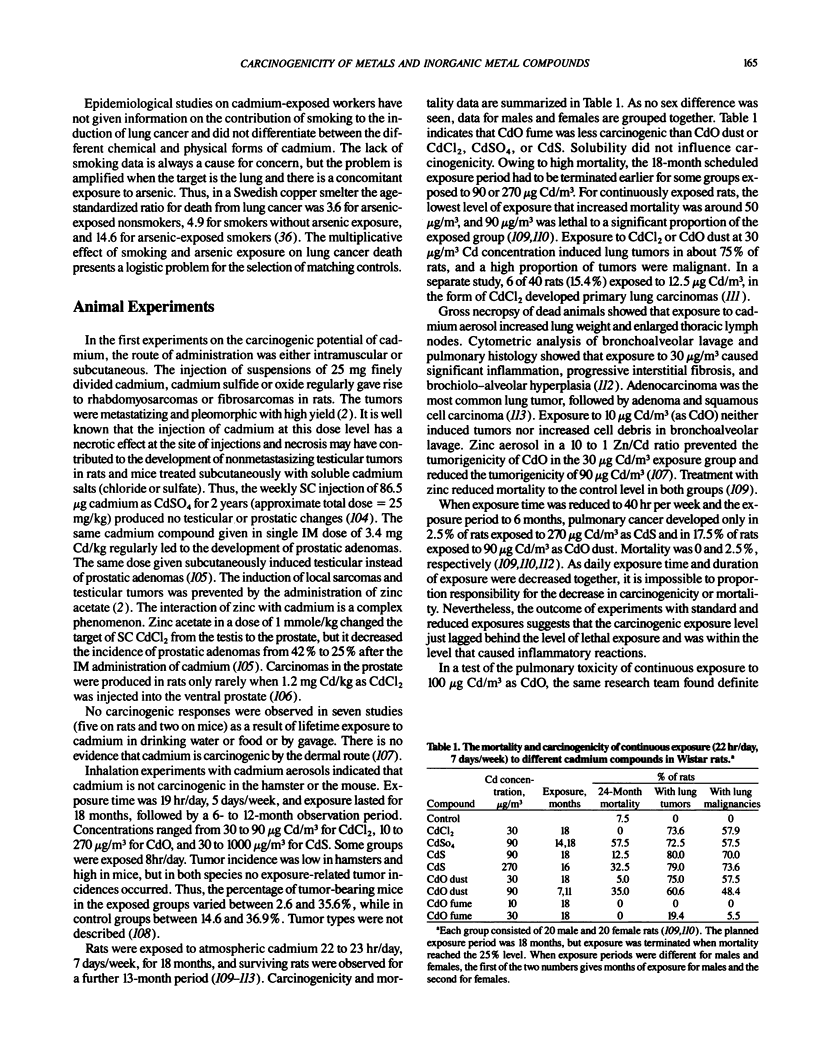


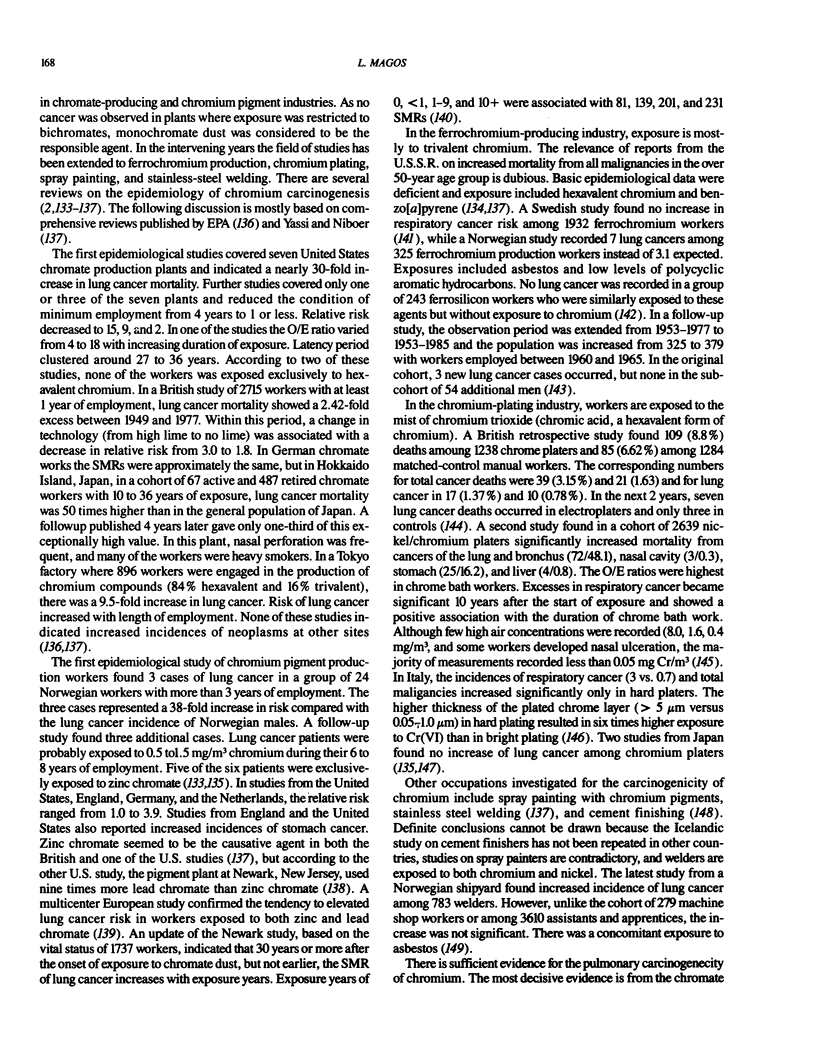
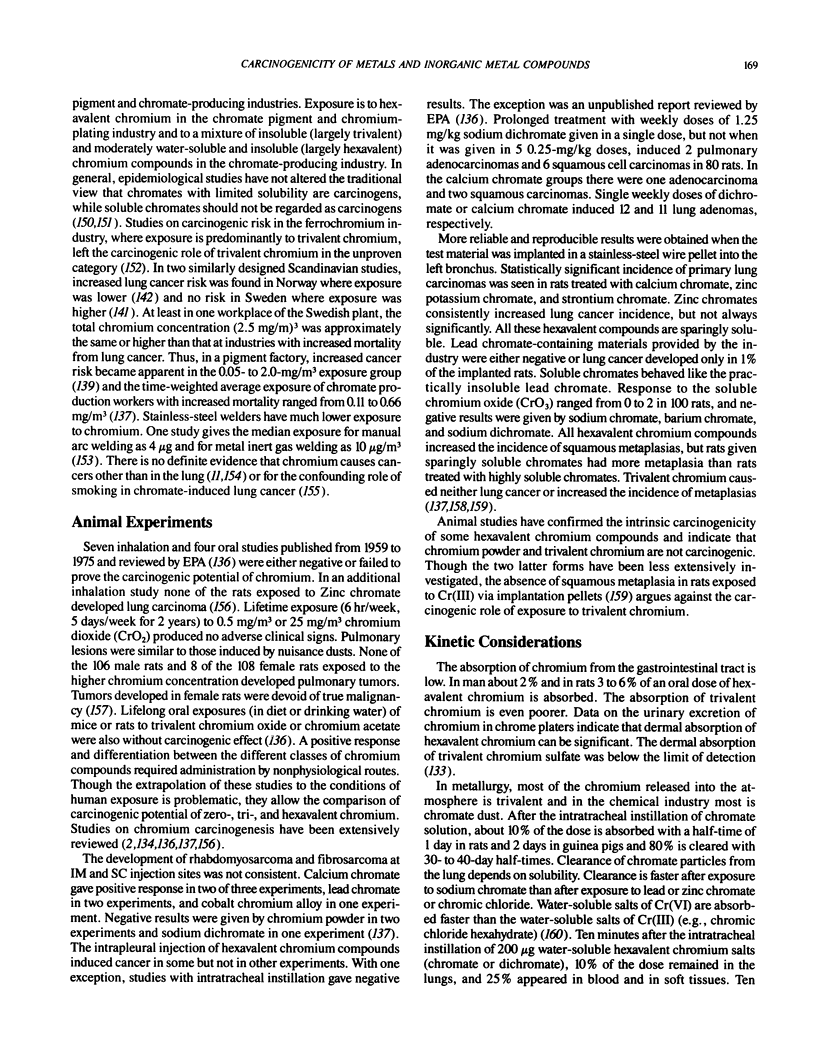


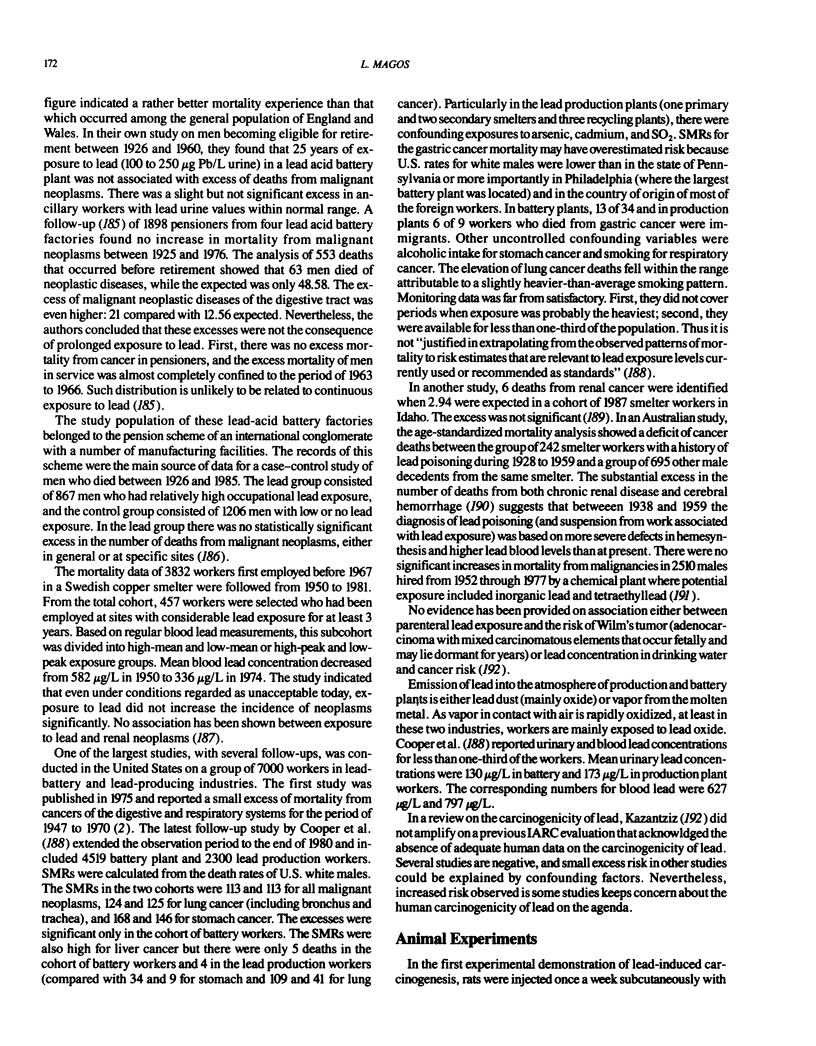
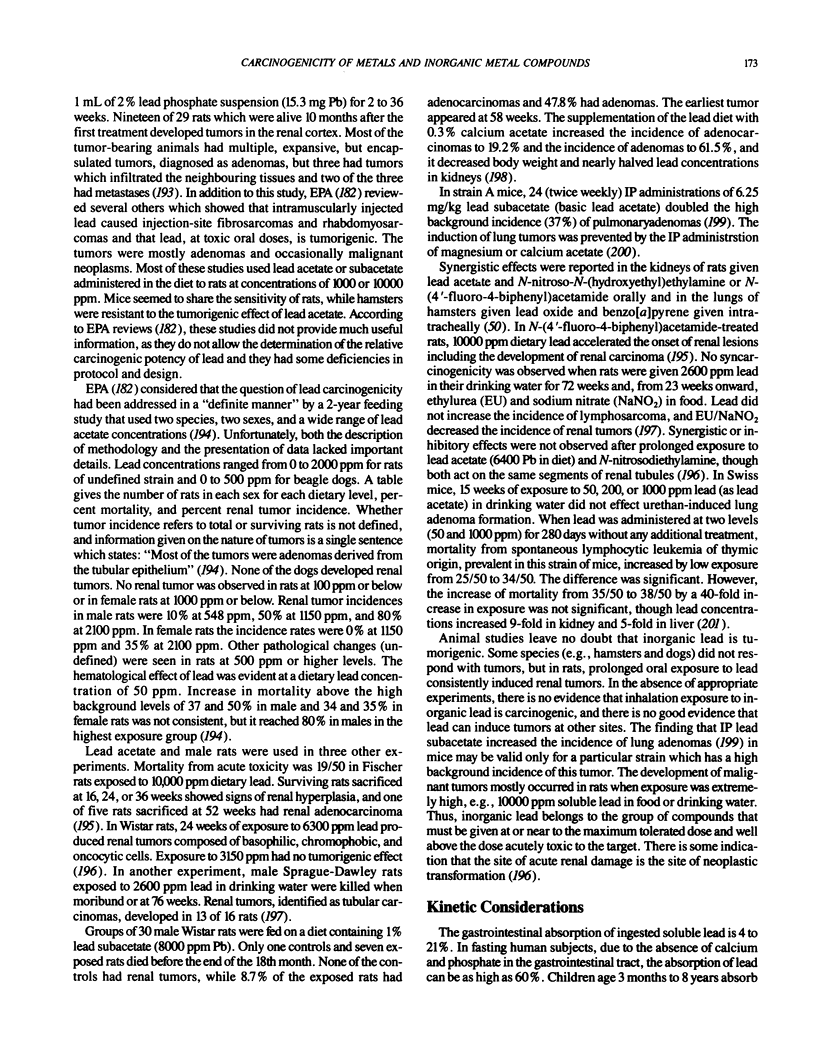



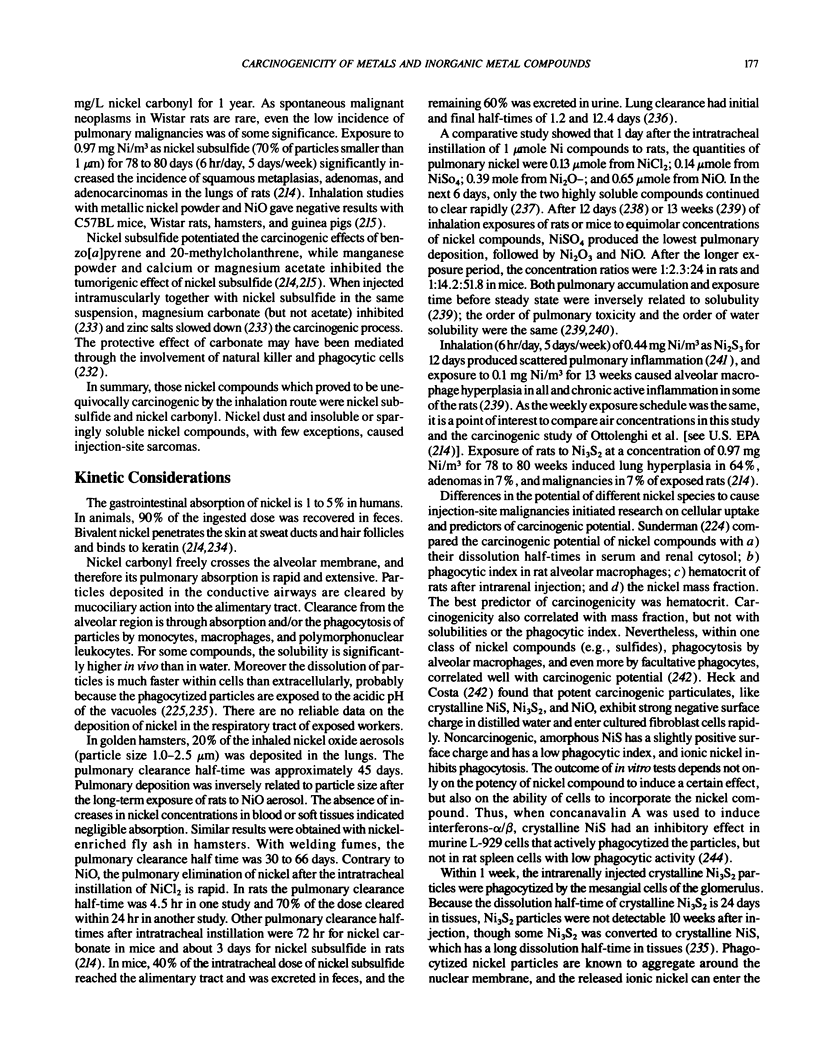
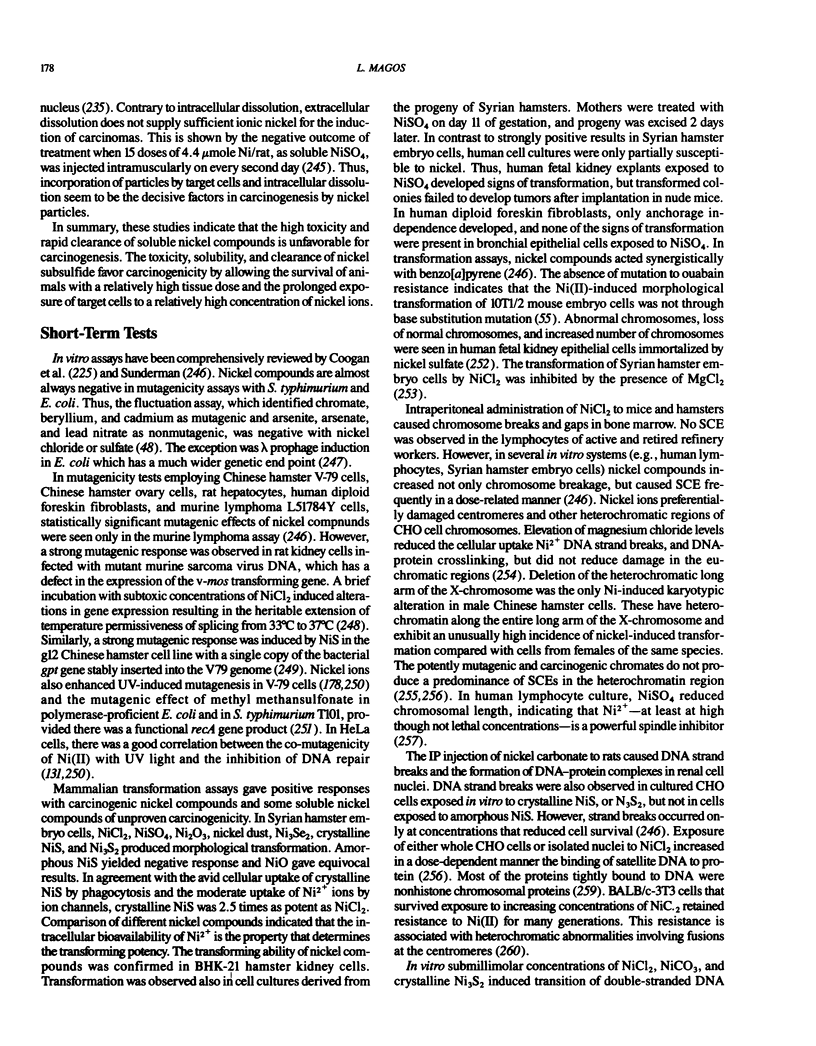


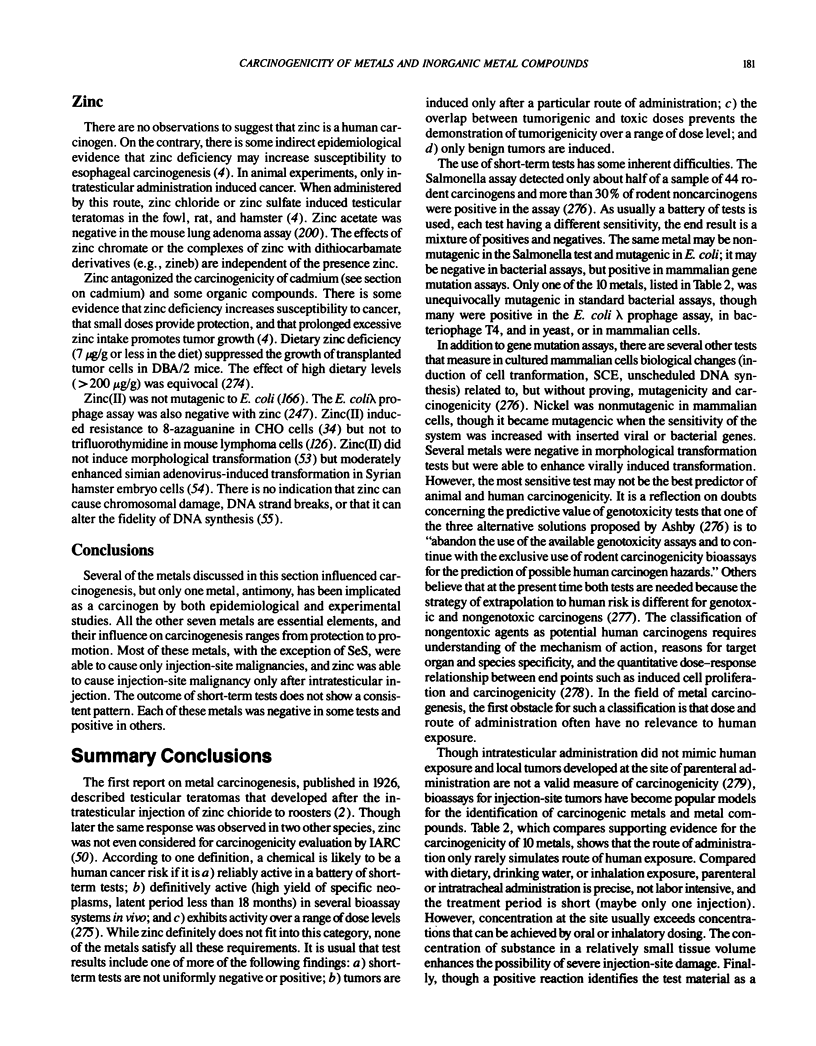


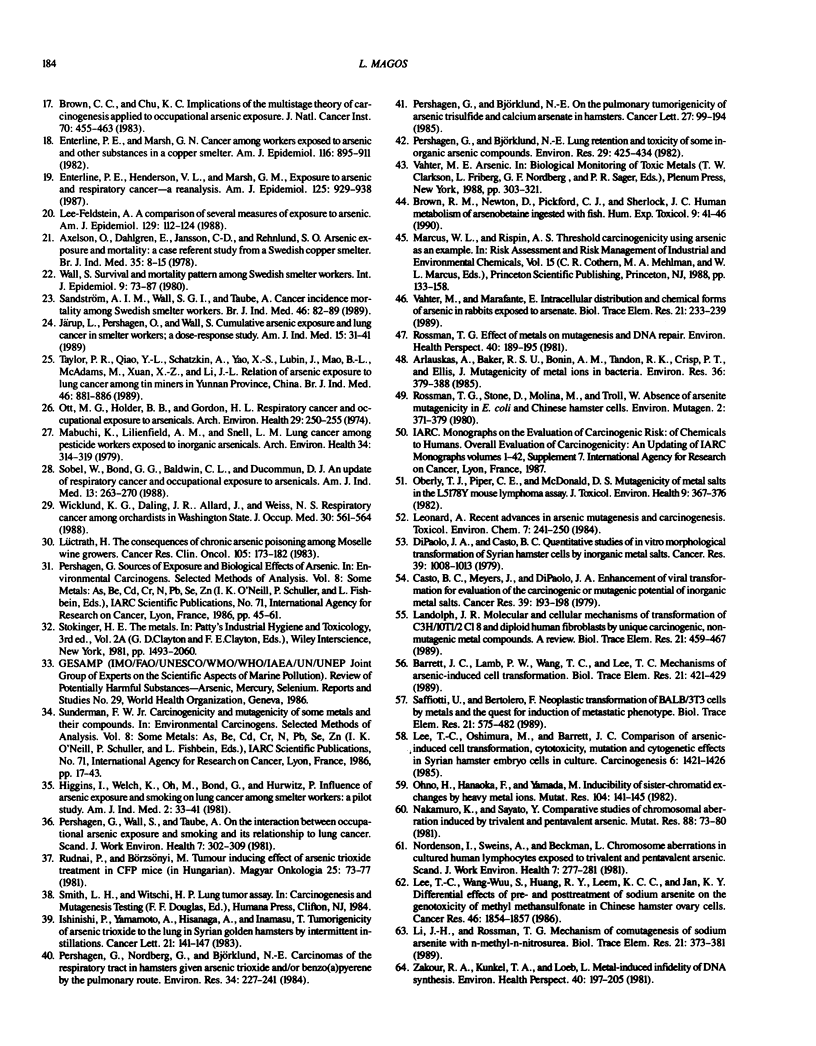


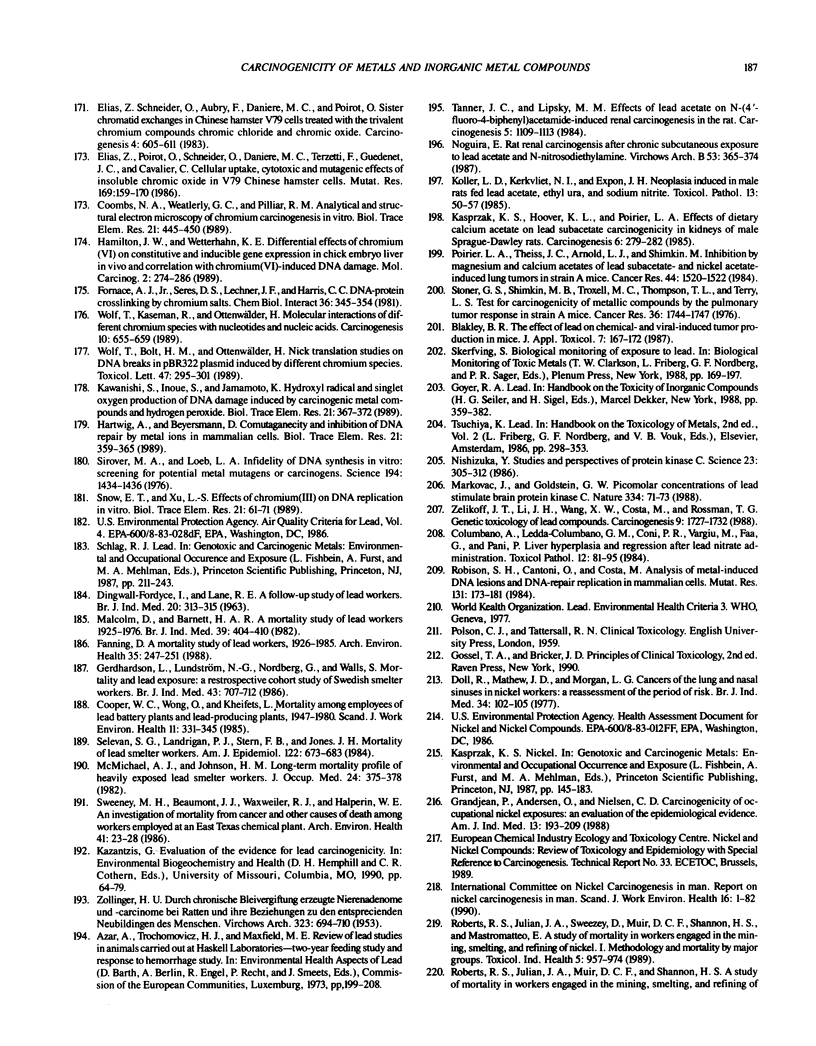

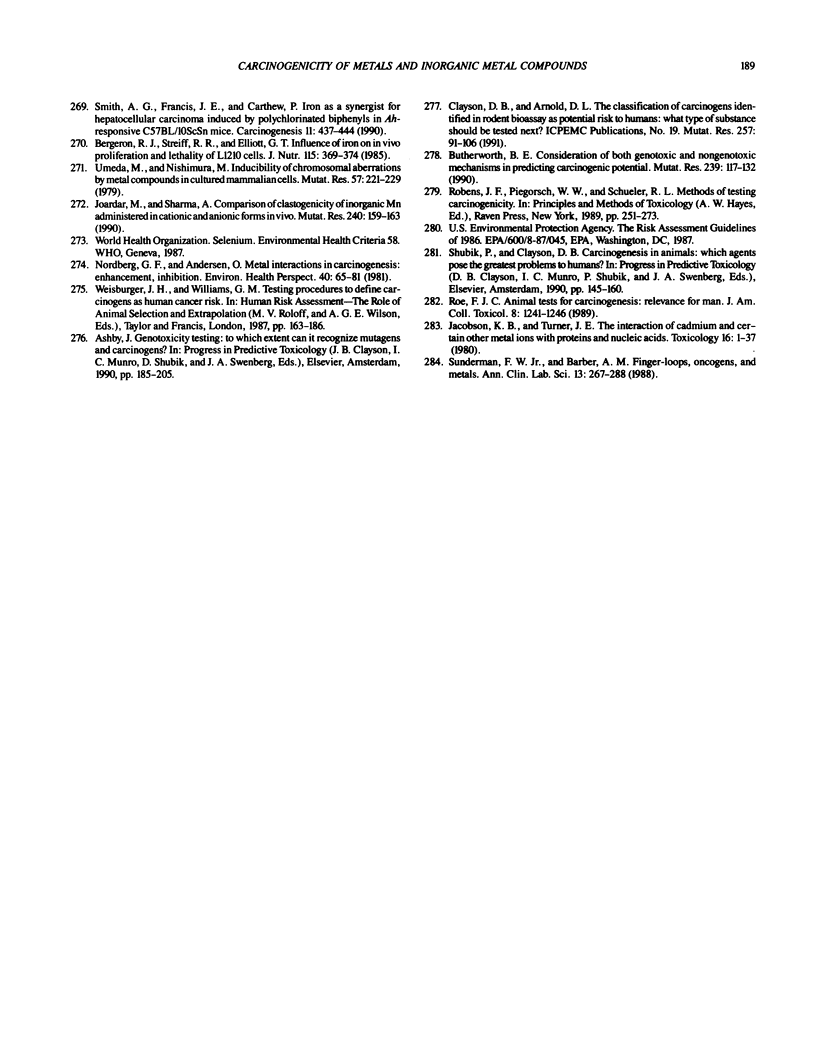
Selected References
These references are in PubMed. This may not be the complete list of references from this article.
- Ades A. E., Kazantzis G. Lung cancer in a non-ferrous smelter: the role of cadmium. Br J Ind Med. 1988 Jul;45(7):435–442. doi: 10.1136/oem.45.7.435. [DOI] [PMC free article] [PubMed] [Google Scholar]
- Amacher D. E., Paillet S. C. Induction of trifluorothymidine-resistant mutants by metal ions in L5178Y/TK+/- cells. Mutat Res. 1980 Jul;78(3):279–288. doi: 10.1016/0165-1218(80)90110-x. [DOI] [PubMed] [Google Scholar]
- Andersen O. Effects of coal combustion products and metal compounds on sister chromatid exchange (SCE) in a macrophagelike cell line. Environ Health Perspect. 1983 Jan;47:239–253. doi: 10.1289/ehp.8347239. [DOI] [PMC free article] [PubMed] [Google Scholar]
- Andersen O. Evaluation of the spindle-inhibiting effect of Ni++ by quantitation of chromosomal super-contraction. Res Commun Chem Pathol Pharmacol. 1985 Dec;50(3):379–386. [PubMed] [Google Scholar]
- Angerer J., Amin W., Heinrich-Ramm R., Szadkowski D., Lehnert G. Occupational chronic exposure to metals. I. Chromium exposure of stainless steel welders--biological monitoring. Int Arch Occup Environ Health. 1987;59(5):503–512. doi: 10.1007/BF00377845. [DOI] [PubMed] [Google Scholar]
- Angerer J., Lehnert G. Occupational chronic exposure to metals. II. Nickel exposure of stainless steel welders--biological monitoring. Int Arch Occup Environ Health. 1990;62(1):7–10. doi: 10.1007/BF00397842. [DOI] [PubMed] [Google Scholar]
- Arillo A., Melodia F., Frache R. Reduction of hexavalent chromium by mitochondria: methodological implications and possible mechanisms. Ecotoxicol Environ Saf. 1987 Oct;14(2):164–177. doi: 10.1016/0147-6513(87)90059-5. [DOI] [PubMed] [Google Scholar]
- Arlauskas A., Baker R. S., Bonin A. M., Tandon R. K., Crisp P. T., Ellis J. Mutagenicity of metal ions in bacteria. Environ Res. 1985 Apr;36(2):379–388. doi: 10.1016/0013-9351(85)90032-5. [DOI] [PubMed] [Google Scholar]
- Armstrong B. G., Kazantzis G. The mortality of cadmium workers. Lancet. 1983 Jun 25;1(8339):1425–1427. doi: 10.1016/s0140-6736(83)92368-1. [DOI] [PubMed] [Google Scholar]
- Ashby J., Ishidate M., Jr, Stoner G. D., Morgan M. A., Ratpan F., Callander R. D. Studies on the genotoxicity of beryllium sulphate in vitro and in vivo. Mutat Res. 1990 Mar;240(3):217–225. doi: 10.1016/0165-1218(90)90061-6. [DOI] [PubMed] [Google Scholar]
- Axelson O., Dahlgren E., Jansson C. D., Rehnlund S. O. Arsenic exposure and mortality: a case-referent study from a Swedish copper smelter. Br J Ind Med. 1978 Feb;35(1):8–15. doi: 10.1136/oem.35.1.8. [DOI] [PMC free article] [PubMed] [Google Scholar]
- Axelsson G., Rylander R., Schmidt A. Mortality and incidence of tumours among ferrochromium workers. Br J Ind Med. 1980 May;37(2):121–127. doi: 10.1136/oem.37.2.121. [DOI] [PMC free article] [PubMed] [Google Scholar]
- BAETJER A. M. Pulmonary carcinoma in chromate workers. 1. A review of the literature and report of cases. AMA Arch Ind Hyg Occup Med. 1950 Nov;2(5):487–504. [PubMed] [Google Scholar]
- Barrett J. C., Lamb P. W., Wang T. C., Lee T. C. Mechanisms of arsenic-induced cell transformation. Biol Trace Elem Res. 1989 Jul-Sep;21:421–429. doi: 10.1007/BF02917284. [DOI] [PubMed] [Google Scholar]
- Benson J. M., Burt D. G., Cheng Y. S., Hahan F. F., Haley P. J., Henderson R. F., Hobbs C. H., Pickrell J. A., Dunnick J. K. Biochemical responses of rat and mouse lung to inhaled nickel compounds. Toxicology. 1989 Aug;57(3):255–266. doi: 10.1016/0300-483x(89)90115-7. [DOI] [PubMed] [Google Scholar]
- Benson J. M., Carpenter R. L., Hahn F. F., Haley P. J., Hanson R. L., Hobbs C. H., Pickrell J. A., Dunnick J. K. Comparative inhalation toxicity of nickel subsulfide to F344/N rats and B6C3F1 mice exposed for 12 days. Fundam Appl Toxicol. 1987 Aug;9(2):251–265. doi: 10.1016/0272-0590(87)90047-9. [DOI] [PubMed] [Google Scholar]
- Benson J. M., Henderson R. F., McClellan R. O., Hanson R. L., Rebar A. H. Comparative acute toxicity of four nickel compounds to F344 rat lung. Fundam Appl Toxicol. 1986 Aug;7(2):340–347. doi: 10.1016/0272-0590(86)90164-8. [DOI] [PubMed] [Google Scholar]
- Bergeron R. J., Streiff R. R., Elliott G. T. Influence of iron on in vivo proliferation and lethality of L1210 cells. J Nutr. 1985 Mar;115(3):369–374. doi: 10.1093/jn/115.3.369. [DOI] [PubMed] [Google Scholar]
- Biedermann K. A., Landolph J. R. Role of valence state and solubility of chromium compounds on induction of cytotoxicity, mutagenesis, and anchorage independence in diploid human fibroblasts. Cancer Res. 1990 Dec 15;50(24):7835–7842. [PubMed] [Google Scholar]
- Biggart N. W., Murphy E. C., Jr Analysis of metal-induced mutations altering the expression or structure of a retroviral gene in a mammalian cell line. Mutat Res. 1988 Mar;198(1):115–129. doi: 10.1016/0027-5107(88)90047-4. [DOI] [PubMed] [Google Scholar]
- Blakley B. R. The effect of lead on chemical- and viral-induced tumor production in mice. J Appl Toxicol. 1987 Jun;7(3):167–172. doi: 10.1002/jat.2550070304. [DOI] [PubMed] [Google Scholar]
- Brooks A. L., Griffith W. C., Johnson N. F., Finch G. L., Cuddihy R. G. The induction of chromosome damage in CHO cells by beryllium and radiation given alone and in combination. Radiat Res. 1989 Dec;120(3):494–507. [PubMed] [Google Scholar]
- Brown C. C., Chu K. C. Implications of the multistage theory of carcinogenesis applied to occupational arsenic exposure. J Natl Cancer Inst. 1983 Mar;70(3):455–463. [PubMed] [Google Scholar]
- Brown K. G., Boyle K. E., Chen C. W., Gibb H. J. A dose-response analysis of skin cancer from inorganic arsenic in drinking water. Risk Anal. 1989 Dec;9(4):519–528. doi: 10.1111/j.1539-6924.1989.tb01263.x. [DOI] [PubMed] [Google Scholar]
- Brown R. M., Newton D., Pickford C. J., Sherlock J. C. Human metabolism of arsenobetaine ingested with fish. Hum Exp Toxicol. 1990 Jan;9(1):41–46. doi: 10.1177/096032719000900109. [DOI] [PubMed] [Google Scholar]
- Butterworth B. E. Consideration of both genotoxic and nongenotoxic mechanisms in predicting carcinogenic potential. Mutat Res. 1990 Sep;239(2):117–132. doi: 10.1016/0165-1110(90)90033-8. [DOI] [PubMed] [Google Scholar]
- Carcinogenicity of chromium and its salts. Br J Ind Med. 1987 May;44(5):355–357. doi: 10.1136/oem.44.5.355-a. [DOI] [PMC free article] [PubMed] [Google Scholar]
- Casto B. C., Meyers J., DiPaolo J. A. Enhancement of viral transformation for evaluation of the carcinogenic or mutagenic potential of inorganic metal salts. Cancer Res. 1979 Jan;39(1):193–198. [PubMed] [Google Scholar]
- Christie N. T., Tummolo D. M. The effect of Ni(II) on DNA replication. Biol Trace Elem Res. 1989 Jul-Sep;21:3–12. doi: 10.1007/BF02917231. [DOI] [PubMed] [Google Scholar]
- Clayson D. B., Arnold D. L. International Commission for Protection Against Environmental Mutagens and Carcinogens. ICPEMC publication No. 19. The classification of carcinogens identified in the rodent bioassay as potential risks to humans: what type of substance should be tested next? Mutat Res. 1991 Jan;257(1):91–106. doi: 10.1016/0165-1110(91)90020-v. [DOI] [PubMed] [Google Scholar]
- Conway K., Costa M. The involvement of heterochromatic damage in nickel-induced transformation. Biol Trace Elem Res. 1989 Jul-Sep;21:437–444. doi: 10.1007/BF02917286. [DOI] [PubMed] [Google Scholar]
- Conway K., Wang X. W., Xu L. S., Costa M. Effect of magnesium on nickel-induced genotoxicity and cell transformation. Carcinogenesis. 1987 Aug;8(8):1115–1121. doi: 10.1093/carcin/8.8.1115. [DOI] [PubMed] [Google Scholar]
- Coogan T. P., Latta D. M., Imbra R. J., Costa M. Effect of nickel(II) on DNA-protein interactions. Biol Trace Elem Res. 1989 Jul-Sep;21:13–21. doi: 10.1007/BF02917232. [DOI] [PubMed] [Google Scholar]
- Coogan T. P., Latta D. M., Snow E. T., Costa M. Toxicity and carcinogenicity of nickel compounds. Crit Rev Toxicol. 1989;19(4):341–384. doi: 10.3109/10408448909029327. [DOI] [PubMed] [Google Scholar]
- Coombs N. A., Weatherly G. C., Pilliar R. M. Analytical and structural electron microscopy of chromium carcinogenesis in vitro. Biol Trace Elem Res. 1989 Jul-Sep;21:445–450. doi: 10.1007/BF02917287. [DOI] [PubMed] [Google Scholar]
- Cooper W. C., Wong O., Kheifets L. Mortality among employees of lead battery plants and lead-producing plants, 1947-1980. Scand J Work Environ Health. 1985 Oct;11(5):331–345. doi: 10.5271/sjweh.2215. [DOI] [PubMed] [Google Scholar]
- DINGWALL-FORDYCE I., LANE R. E. A FOLLOW-UP STUDY OF LEAD WORKERS. Br J Ind Med. 1963 Oct;20:313–315. doi: 10.1136/oem.20.4.313. [DOI] [PMC free article] [PubMed] [Google Scholar]
- Debetto P., Luciani S. Toxic effect of chromium on cellular metabolism. Sci Total Environ. 1988 Jun 1;71(3):365–377. doi: 10.1016/0048-9697(88)90209-4. [DOI] [PubMed] [Google Scholar]
- Denizeau F., Marion M. Genotoxic effects of heavy metals in rat hepatocytes. Cell Biol Toxicol. 1989 Jan;5(1):15–25. doi: 10.1007/BF00141061. [DOI] [PubMed] [Google Scholar]
- DiPaolo J. A., Casto B. C. Quantitative studies of in vitro morphological transformation of Syrian hamster cells by inorganic metal salts. Cancer Res. 1979 Mar;39(3):1008–1013. [PubMed] [Google Scholar]
- Doll R., Mathews J. D., Morgan L. G. Cancers of the lung and nasal sinuses in nickel workers: a reassessment of the period of risk. Br J Ind Med. 1977 May;34(2):102–105. doi: 10.1136/oem.34.2.102. [DOI] [PMC free article] [PubMed] [Google Scholar]
- Doll R. Occupational cancer: a hazard for epidemiologists. Int J Epidemiol. 1985 Mar;14(1):22–31. doi: 10.1093/ije/14.1.22. [DOI] [PubMed] [Google Scholar]
- Doll R. Occupational cancer: problems in interpreting human evidence. Ann Occup Hyg. 1984;28(3):291–305. doi: 10.1093/annhyg/28.3.291. [DOI] [PubMed] [Google Scholar]
- Dubins J. S., LaVelle J. M. Nickel(II) genotoxicity: potentiation of mutagenesis of simple alkylating agents. Mutat Res. 1986 Sep;162(2):187–199. doi: 10.1016/0027-5107(86)90085-0. [DOI] [PubMed] [Google Scholar]
- Dunnick J. K., Benson J. M., Hobbs C. H., Hahn F. F., Cheng Y. S., Eidson A. F. Comparative toxicity of nickel oxide, nickel sulfate hexahydrate, and nickel subsulfide after 12 days of inhalation exposure to F344/N rats and B6C3F1 mice. Toxicology. 1988 Jul;50(2):145–156. doi: 10.1016/0300-483x(88)90087-x. [DOI] [PubMed] [Google Scholar]
- Dunnick J. K., Elwell M. R., Benson J. M., Hobbs C. H., Hahn F. F., Haly P. J., Cheng Y. S., Eidson A. F. Lung toxicity after 13-week inhalation exposure to nickel oxide, nickel subsulfide, or nickel sulfate hexahydrate in F344/N rats and B6C3F1 mice. Fundam Appl Toxicol. 1989 Apr;12(3):584–594. doi: 10.1016/0272-0590(89)90031-6. [DOI] [PubMed] [Google Scholar]
- Elias Z., Poirot O., Schneider O., Danière M. C., Terzetti F., Guedenet J. C., Cavelier C. Cellular uptake, cytotoxic and mutagenic effects of insoluble chromic oxide in V79 Chinese hamster cells. Mutat Res. 1986 Mar;169(3):159–170. doi: 10.1016/0165-1218(86)90095-9. [DOI] [PubMed] [Google Scholar]
- Elias Z., Schneider O., Aubry F., Daniere M. C., Poirot O. Sister chromatid exchanges in Chinese hamster V79 cells treated with the trivalent chromium compounds chromic chloride and chromic oxide. Carcinogenesis. 1983;4(5):605–611. doi: 10.1093/carcin/4.5.605. [DOI] [PubMed] [Google Scholar]
- Elinder C. G., Kjellström T., Hogstedt C., Andersson K., Spång G. Cancer mortality of cadmium workers. Br J Ind Med. 1985 Oct;42(10):651–655. doi: 10.1136/oem.42.10.651. [DOI] [PMC free article] [PubMed] [Google Scholar]
- Enterline P. E., Henderson V. L., Marsh G. M. Exposure to arsenic and respiratory cancer. A reanalysis. Am J Epidemiol. 1987 Jun;125(6):929–938. doi: 10.1093/oxfordjournals.aje.a114631. [DOI] [PubMed] [Google Scholar]
- Enterline P. E., Marsh G. M. Cancer among workers exposed to arsenic and other substances in a copper smelter. Am J Epidemiol. 1982 Dec;116(6):895–911. doi: 10.1093/oxfordjournals.aje.a113492. [DOI] [PubMed] [Google Scholar]
- Fanning D. A mortality study of lead workers, 1926-1985. Arch Environ Health. 1988 May-Jun;43(3):247–251. doi: 10.1080/00039896.1988.9934942. [DOI] [PubMed] [Google Scholar]
- Finch G. L., Verburg R. J., Mewhinney J. A., Eidson A. F., Hoover M. D. The effect of beryllium compound solubility on in vitro canine alveolar macrophage cytotoxicity. Toxicol Lett. 1988 May;41(2):97–105. doi: 10.1016/0378-4274(88)90083-5. [DOI] [PubMed] [Google Scholar]
- Fisher G. L., Chrisp C. E., McNeill D. A. Lifetime effects of intratracheally instilled nickel subsulfide on B6C3F1 mice. Environ Res. 1986 Aug;40(2):313–320. doi: 10.1016/s0013-9351(86)80106-2. [DOI] [PubMed] [Google Scholar]
- Fornace A. J., Jr, Seres D. S., Lechner J. F., Harris C. C. DNA-protein cross-linking by chromium salts. Chem Biol Interact. 1981 Sep;36(3):345–354. doi: 10.1016/0009-2797(81)90077-6. [DOI] [PubMed] [Google Scholar]
- Franchini I., Magnani F., Mutti A. Mortality experience among chromeplating workers. Initial findings. Scand J Work Environ Health. 1983 Jun;9(3):247–252. doi: 10.5271/sjweh.2413. [DOI] [PubMed] [Google Scholar]
- Frentzel-Beyme R. Lung cancer mortality of workers employed in chromate pigment factories. A multicentric European epidemiological study. J Cancer Res Clin Oncol. 1983;105(2):183–188. doi: 10.1007/BF00406930. [DOI] [PubMed] [Google Scholar]
- Gerhardsson L., Lundström N. G., Nordberg G., Wall S. Mortality and lead exposure: a retrospective cohort study of Swedish smelter workers. Br J Ind Med. 1986 Oct;43(10):707–712. doi: 10.1136/oem.43.10.707. [DOI] [PMC free article] [PubMed] [Google Scholar]
- Glaser U., Klöppel H., Hochrainer D. Bioavailability indicators of inhaled cadmium compounds. Ecotoxicol Environ Saf. 1986 Jun;11(3):261–271. doi: 10.1016/0147-6513(86)90100-4. [DOI] [PubMed] [Google Scholar]
- Grandjean P., Andersen O., Nielsen G. D. Carcinogenicity of occupational nickel exposures: an evaluation of the epidemiological evidence. Am J Ind Med. 1988;13(2):193–209. doi: 10.1002/ajim.4700130202. [DOI] [PubMed] [Google Scholar]
- Grose E. C., Richards J. H., Jaskot R. H., Ménache M. G., Graham J. A., Dauterman W. C. A comparative study of the effects of inhaled cadmium chloride and cadmium oxide: pulmonary response. J Toxicol Environ Health. 1987;21(1-2):219–232. doi: 10.1080/15287398709531014. [DOI] [PubMed] [Google Scholar]
- Groth D. H., Stettler L. E., Burg J. R., Busey W. M., Grant G. C., Wong L. Carcinogenic effects of antimony trioxide and antimony ore concentrate in rats. J Toxicol Environ Health. 1986;18(4):607–626. doi: 10.1080/15287398609530898. [DOI] [PubMed] [Google Scholar]
- Hamilton J. W., Wetterhahn K. E. Differential effects of chromium(VI) on constitutive and inducible gene expression in chick embryo liver in vivo and correlation with chromium(VI)-induced DNA damage. Mol Carcinog. 1989;2(5):274–286. doi: 10.1002/mc.2940020508. [DOI] [PubMed] [Google Scholar]
- Hart B. A. Cellular and biochemical response of the rat lung to repeated inhalation of cadmium. Toxicol Appl Pharmacol. 1986 Feb;82(2):281–291. doi: 10.1016/0041-008x(86)90203-6. [DOI] [PubMed] [Google Scholar]
- Hartwig A., Beyersmann D. Comutagenicity and inhibition of DNA repair by metal ions in mammalian cells. Biol Trace Elem Res. 1989 Jul-Sep;21:359–365. doi: 10.1007/BF02917276. [DOI] [PubMed] [Google Scholar]
- Hathaway J. A. Role of epidemiologic studies in evaluating the carcinogenicity of chromium compounds. Sci Total Environ. 1989 Oct 1;86(1-2):169–179. doi: 10.1016/0048-9697(89)90203-9. [DOI] [PubMed] [Google Scholar]
- Haugen A., Ryberg D., Hansteen I. L., Dalen H. Transformation of human kidney epithelial cells to tumorigenicity by nickel(II) and V-HA-RAS oncogene. Biol Trace Elem Res. 1989 Jul-Sep;21:451–458. doi: 10.1007/BF02917288. [DOI] [PubMed] [Google Scholar]
- Hayes R. B., Sheffet A., Spirtas R. Cancer mortality among a cohort of chromium pigment workers. Am J Ind Med. 1989;16(2):127–133. doi: 10.1002/ajim.4700160204. [DOI] [PubMed] [Google Scholar]
- Heck J. D., Costa M. Influence of surface charge and dissolution on the selective phagocytosis of potentially carcinogenic particulate metal compounds. Cancer Res. 1983 Dec;43(12 Pt 1):5652–5656. [PubMed] [Google Scholar]
- Heinrich U., Peters L., Ernst H., Rittinghausen S., Dasenbrock C., König H. Investigation on the carcinogenic effects of various cadmium compounds after inhalation exposure in hamsters and mice. Exp Pathol. 1989;37(1-4):253–258. doi: 10.1016/s0232-1513(89)80063-5. [DOI] [PubMed] [Google Scholar]
- Higgins I., Welch K., Oh M., Bond G., Hurwitz P. Influence of arsenic exposure and smoking on lung cancer among smelter workers: a pilot study. Am J Ind Med. 1981;2(1):33–41. doi: 10.1002/ajim.4700020107. [DOI] [PubMed] [Google Scholar]
- Hirano S., Tsukamoto N., Higo S., Suzuki K. T. Toxicity of cadmium oxide instilled into the rat lung. II. Inflammatory responses in broncho-alveolar lavage fluid. Toxicology. 1989 Apr;55(1-2):25–35. doi: 10.1016/0300-483x(89)90172-8. [DOI] [PubMed] [Google Scholar]
- Hirano S., Tsukamoto N., Kobayashi E., Suzuki K. T. Toxicity of cadmium oxide instilled into the rat lung. I. Metabolism of cadmium oxide in the lung and its effects on essential elements. Toxicology. 1989 Apr;55(1-2):15–24. doi: 10.1016/0300-483x(89)90171-6. [DOI] [PubMed] [Google Scholar]
- Hoffmann L., Putzke H. P., Kampehl H. J., Russbült R., Gase P., Simonn C., Erdmann T., Huckstorf C. Carcinogenic effects of cadmium on the prostate of the rat. J Cancer Res Clin Oncol. 1985;109(3):193–199. doi: 10.1007/BF00390356. [DOI] [PubMed] [Google Scholar]
- Ishinishi N., Yamamoto A., Hisanaga A., Inamasu T. Tumorigenicity of arsenic trioxide to the lung in Syrian golden hamsters by intermittent instillations. Cancer Lett. 1983 Dec;21(2):141–147. doi: 10.1016/0304-3835(83)90200-8. [DOI] [PubMed] [Google Scholar]
- Jacobson-Kram D., Montalbano D. The reproductive effects assessment group's report on the mutagenicity of inorganic arsenic. Environ Mutagen. 1985;7(5):787–804. doi: 10.1002/em.2860070515. [DOI] [PubMed] [Google Scholar]
- Jacobson K. B., Turner J. E. The interaction of cadmium and certain other metal ions with proteins and nucleic acids. Toxicology. 1980;16(1):1–37. doi: 10.1016/0300-483x(80)90107-9. [DOI] [PubMed] [Google Scholar]
- Jaramillo A., Sonnenfeld G. Effects of amorphous and crystalline nickel sulfide on induction of interferons-alpha/beta and -gamma and interleukin-2. Environ Res. 1989 Apr;48(2):275–286. doi: 10.1016/s0013-9351(89)80040-4. [DOI] [PubMed] [Google Scholar]
- Joardar M., Sharma A. Comparison of clastogenicity of inorganic Mn administered in cationic and anionic forms in vivo. Mutat Res. 1990 Mar;240(3):159–163. doi: 10.1016/0165-1218(90)90055-7. [DOI] [PubMed] [Google Scholar]
- Johansson A., Wiernik A., Jarstrand C., Camner P. Rabbit alveolar macrophages after inhalation of hexa- and trivalent chromium. Environ Res. 1986 Apr;39(2):372–385. doi: 10.1016/s0013-9351(86)80063-9. [DOI] [PubMed] [Google Scholar]
- Järup L., Pershagen G., Wall S. Cumulative arsenic exposure and lung cancer in smelter workers: a dose-response study. Am J Ind Med. 1989;15(1):31–41. doi: 10.1002/ajim.4700150105. [DOI] [PubMed] [Google Scholar]
- Kanematsu N., Hara M., Kada T. Rec assay and mutagenicity studies on metal compounds. Mutat Res. 1980 Feb;77(2):109–116. doi: 10.1016/0165-1218(80)90127-5. [DOI] [PubMed] [Google Scholar]
- Kasprzak K. S., Bare R. M. In vitro polymerization of histones by carcinogenic nickel compounds. Carcinogenesis. 1989 Mar;10(3):621–624. doi: 10.1093/carcin/10.3.621. [DOI] [PubMed] [Google Scholar]
- Kasprzak K. S., Gabryel P., Jarczewska K. Carcinogenicity of nickel(II)hydroxides and nickel(II)sulfate in Wistar rats and its relation to the in vitro dissolution rates. Carcinogenesis. 1983;4(3):275–279. doi: 10.1093/carcin/4.3.275. [DOI] [PubMed] [Google Scholar]
- Kasprzak K. S., Hoover K. L., Poirier L. A. Effects of dietary calcium acetate on lead subacetate carcinogenicity in kidneys of male Sprague-Dawley rats. Carcinogenesis. 1985 Feb;6(2):279–282. doi: 10.1093/carcin/6.2.279. [DOI] [PubMed] [Google Scholar]
- Kasprzak K. S., Kovatch R. M., Poirier L. A. Inhibitory effect of zinc on nickel subsulfide carcinogenesis in Fischer rats. Toxicology. 1988 Nov 30;52(3):253–262. doi: 10.1016/0300-483x(88)90130-8. [DOI] [PubMed] [Google Scholar]
- Kasprzak K. S., Ward J. M., Poirier L. A., Reichardt D. A., Denn A. C., 3rd, Reynolds C. W. Nickel--magnesium interactions in carcinogenesis: dose effects and involvement of natural killer cells. Carcinogenesis. 1987 Jul;8(7):1005–1011. doi: 10.1093/carcin/8.7.1005. [DOI] [PubMed] [Google Scholar]
- Kawanishi S., Inoue S., Yamamoto K. Hydroxyl radical and singlet oxygen production and DNA damage induced by carcinogenic metal compounds and hydrogen peroxide. Biol Trace Elem Res. 1989 Jul-Sep;21:367–372. doi: 10.1007/BF02917277. [DOI] [PubMed] [Google Scholar]
- Kazantzis G., Lam T. H. Cancer mortality of cadmium workers. Br J Ind Med. 1986 Jun;43(6):430–431. doi: 10.1136/oem.43.6.430. [DOI] [PMC free article] [PubMed] [Google Scholar]
- Kazantzis G., Lam T. H., Sullivan K. R. Mortality of cadmium-exposed workers. A five-year update. Scand J Work Environ Health. 1988 Aug;14(4):220–223. doi: 10.5271/sjweh.1929. [DOI] [PubMed] [Google Scholar]
- Koller L. D., Kerkvliet N. I., Exon J. H. Neoplasia induced in male rats fed lead acetate, ethyl urea, and sodium nitrite. Toxicol Pathol. 1985;13(1):50–57. doi: 10.1177/019262338501300107. [DOI] [PubMed] [Google Scholar]
- Kreyberg L. Lung cancer in workers in a nickel refinery. Br J Ind Med. 1978 May;35(2):109–116. doi: 10.1136/oem.35.2.109. [DOI] [PMC free article] [PubMed] [Google Scholar]
- Kriebel D., Brain J. D., Sprince N. L., Kazemi H. The pulmonary toxicity of beryllium. Am Rev Respir Dis. 1988 Feb;137(2):464–473. doi: 10.1164/ajrccm/137.2.464. [DOI] [PubMed] [Google Scholar]
- Landolph J. R. Molecular and cellular mechanisms of transformation of C3H/10T1/2 Cl 8 and diploid human fibroblasts by unique carcinogenic, nonmutagenic metal compounds. A review. Biol Trace Elem Res. 1989 Jul-Sep;21:459–467. doi: 10.1007/BF02917289. [DOI] [PubMed] [Google Scholar]
- Langård S., Andersen A. a., Gylseth B. Incidence of cancer among ferrochromium and ferrosilicon workers. Br J Ind Med. 1980 May;37(2):114–120. doi: 10.1136/oem.37.2.114. [DOI] [PMC free article] [PubMed] [Google Scholar]
- Langård S., Andersen A., Ravnestad J. Incidence of cancer among ferrochromium and ferrosilicon workers: an extended observation period. Br J Ind Med. 1990 Jan;47(1):14–19. doi: 10.1136/oem.47.1.14. [DOI] [PMC free article] [PubMed] [Google Scholar]
- Langård S. Chromium carcinogenicity; a review of experimental animal data. Sci Total Environ. 1988 Jun 1;71(3):341–350. doi: 10.1016/0048-9697(88)90206-9. [DOI] [PubMed] [Google Scholar]
- Langård S. One hundred years of chromium and cancer: a review of epidemiological evidence and selected case reports. Am J Ind Med. 1990;17(2):189–215. doi: 10.1002/ajim.4700170205. [DOI] [PubMed] [Google Scholar]
- Lauwerys R. R. Metals--epidemiological and experimental evidence for carcinogenicity. Arch Toxicol Suppl. 1989;13:21–27. doi: 10.1007/978-3-642-74117-3_2. [DOI] [PubMed] [Google Scholar]
- Lee-Feldstein A. A comparison of several measures of exposure to arsenic. Matched case-control study of copper smelter employees. Am J Epidemiol. 1989 Jan;129(1):112–124. doi: 10.1093/oxfordjournals.aje.a115100. [DOI] [PubMed] [Google Scholar]
- Lee A. M., Fraumeni J. F., Jr Arsenic and respiratory cancer in man: an occupational study. J Natl Cancer Inst. 1969 Jun;42(6):1045–1052. [PubMed] [Google Scholar]
- Lee T. C., Oshimura M., Barrett J. C. Comparison of arsenic-induced cell transformation, cytotoxicity, mutation and cytogenetic effects in Syrian hamster embryo cells in culture. Carcinogenesis. 1985 Oct;6(10):1421–1426. doi: 10.1093/carcin/6.10.1421. [DOI] [PubMed] [Google Scholar]
- Lee T. C., Wang-Wuu S., Huang R. Y., Lee K. C., Jan K. Y. Differential effects of pre- and posttreatment of sodium arsenite on the genotoxicity of methyl methanesulfonate in Chinese hamster ovary cells. Cancer Res. 1986 Apr;46(4 Pt 1):1854–1857. [PubMed] [Google Scholar]
- Lemen R. A., Lee J. S., Wagoner J. K., Blejer H. P. Cancer mortality among cadmium production workers. Ann N Y Acad Sci. 1976;271:273–279. doi: 10.1111/j.1749-6632.1976.tb23122.x. [DOI] [PubMed] [Google Scholar]
- Levy L. S., Martin P. A., Bidstrup P. L. Investigation of the potential carcinogenicity of a range of chromium containing materials on rat lung. Br J Ind Med. 1986 Apr;43(4):243–256. doi: 10.1136/oem.43.4.243. [DOI] [PMC free article] [PubMed] [Google Scholar]
- Levy L. S., Roe F. J., Malcolm D., Kazantzis G., Clack J., Platt H. S. Absence of prostatic changes in rats exposed to cadmium. Ann Occup Hyg. 1973 Aug;16(2):111–118. doi: 10.1093/annhyg/16.2.111. [DOI] [PubMed] [Google Scholar]
- Levy L. S., Venitt S. Carcinogenicity and mutagenicity of chromium compounds: the association between bronchial metaplasia and neoplasia. Carcinogenesis. 1986 May;7(5):831–835. doi: 10.1093/carcin/7.5.831. [DOI] [PubMed] [Google Scholar]
- Li J. H., Rossman T. G. Mechanism of comutagenesis of sodium arsenite with n-methyl-n-nitrosourea. Biol Trace Elem Res. 1989 Jul-Sep;21:373–381. doi: 10.1007/BF02917278. [DOI] [PubMed] [Google Scholar]
- Lumb G., Sunderman F. W., Sr The mechanism of malignant tumor induction by nickel subsulfide. Ann Clin Lab Sci. 1988 Sep-Oct;18(5):353–366. [PubMed] [Google Scholar]
- Malcolm D., Barnett H. A. A mortality study of lead workers 1925-76. Br J Ind Med. 1982 Nov;39(4):404–410. doi: 10.1136/oem.39.4.404. [DOI] [PMC free article] [PubMed] [Google Scholar]
- Mandel R., Ryser H. J. Mechanisms of synergism in the mutagenicity of cadmium and N-methyl-N-nitrosourea in Salmonella typhimurium: the effect of pH. Mutat Res. 1987 Jan;176(1):1–10. doi: 10.1016/0027-5107(87)90246-6. [DOI] [PubMed] [Google Scholar]
- Markovac J., Goldstein G. W. Picomolar concentrations of lead stimulate brain protein kinase C. Nature. 1988 Jul 7;334(6177):71–73. doi: 10.1038/334071a0. [DOI] [PubMed] [Google Scholar]
- McMichael A. J., Johnson H. M. Long-term mortality profile of heavily-exposed lead smelter workers. J Occup Med. 1982 May;24(5):375–378. doi: 10.1097/00043764-198205000-00008. [DOI] [PubMed] [Google Scholar]
- McNeill D. A., Chrisp C. E., Fisher G. L. Tumorigenicity of nickel subsulfide in Strain A/J mice. Drug Chem Toxicol. 1990;13(1):71–86. doi: 10.3109/01480549009011070. [DOI] [PubMed] [Google Scholar]
- Meek J., Nieuwenhuys R., Elsevier D. Afferent and efferent connections of cerebellar lobe C1 of the mormyrid fish Gnathonemus petersi: an HRP study. J Comp Neurol. 1986 Mar 15;245(3):319–341. doi: 10.1002/cne.902450304. [DOI] [PubMed] [Google Scholar]
- Melkild A., Langård S., Andersen A., Tønnessen J. N. Incidence of cancer among welders and other workers in a Norwegian shipyard. Scand J Work Environ Health. 1989 Dec;15(6):387–394. doi: 10.5271/sjweh.1834. [DOI] [PubMed] [Google Scholar]
- Miyaki M., Akamatsu N., Ono T., Koyama H. Mutagenicity of metal cations in cultured cells from Chinese hamster. Mutat Res. 1979 Nov;68(3):259–263. doi: 10.1016/0165-1218(79)90157-5. [DOI] [PubMed] [Google Scholar]
- Nakamuro K., Sayato Y. Comparative studies of chromosomal aberration induced by trivalent and pentavalent arsenic. Mutat Res. 1981 Jan;88(1):73–80. doi: 10.1016/0165-1218(81)90091-4. [DOI] [PubMed] [Google Scholar]
- Nieboer E., Tom R. T., Rossetto F. E. Superoxide dismutase activity and novel reactions with hydrogen peroxide of histidine-containing nickel(II)-oligopeptide complexes and nickel(II)-induced structural changes in synthetic DNA. Biol Trace Elem Res. 1989 Jul-Sep;21:23–33. doi: 10.1007/BF02917233. [DOI] [PubMed] [Google Scholar]
- Nishizuka Y. Studies and perspectives of protein kinase C. Science. 1986 Jul 18;233(4761):305–312. doi: 10.1126/science.3014651. [DOI] [PubMed] [Google Scholar]
- Nocentini S. Inhibition of DNA replication and repair by cadmium in mammalian cells. Protective interaction of zinc. Nucleic Acids Res. 1987 May 26;15(10):4211–4225. doi: 10.1093/nar/15.10.4211. [DOI] [PMC free article] [PubMed] [Google Scholar]
- Nogueira E. Rat renal carcinogenesis after chronic simultaneous exposure to lead acetate and N-nitrosodiethylamine. Virchows Arch B Cell Pathol Incl Mol Pathol. 1987;53(6):365–374. doi: 10.1007/BF02890265. [DOI] [PubMed] [Google Scholar]
- Nordberg G. F., Andersen O. Metal interactions in carcinogenesis: enhancement, inhibition. Environ Health Perspect. 1981 Aug;40:65–81. doi: 10.1289/ehp.814065. [DOI] [PMC free article] [PubMed] [Google Scholar]
- Nordenson I., Sweins A., Beckman L. Chromosome aberrations in cultured human lymphocytes exposed to trivalent and pentavalent arsenic. Scand J Work Environ Health. 1981 Dec;7(4):277–281. doi: 10.5271/sjweh.2551. [DOI] [PubMed] [Google Scholar]
- Norseth T. Metal carcinogenesis. Ann N Y Acad Sci. 1988;534:377–386. doi: 10.1111/j.1749-6632.1988.tb30125.x. [DOI] [PubMed] [Google Scholar]
- Norseth T. The carcinogenicity of chromium and its salts. Br J Ind Med. 1986 Oct;43(10):649–651. doi: 10.1136/oem.43.10.649. [DOI] [PMC free article] [PubMed] [Google Scholar]
- Oberdörster G. Airborne cadmium and carcinogenesis of the respiratory tract. Scand J Work Environ Health. 1986 Dec;12(6):523–537. [PubMed] [Google Scholar]
- Oberly T. J., Piper C. E., McDonald D. S. Mutagenicity of metal salts in the L5178Y mouse lymphoma assay. J Toxicol Environ Health. 1982 Mar;9(3):367–376. doi: 10.1080/15287398209530170. [DOI] [PubMed] [Google Scholar]
- Ohno H., Hanaoka F., Yamada M. Inducibility of sister-chromatid exchanges by heavy-metal ions. Mutat Res. 1982 Apr;104(1-3):141–145. doi: 10.1016/0165-7992(82)90135-x. [DOI] [PubMed] [Google Scholar]
- Ott M. G., Holder B. B., Gordon H. L. Respiratory cancer and occupational exposure to arsenicals. Arch Environ Health. 1974 Nov;29(5):250–255. doi: 10.1080/00039896.1974.10666582. [DOI] [PubMed] [Google Scholar]
- POTTS C. L. CADMIUM PROTEINURIA--THE HEALTH OF BATTERY WORKERS EXPOSED TO CADMIUM OXIDE DUST. Ann Occup Hyg. 1965 Mar;8:55–61. doi: 10.1093/annhyg/8.1.55. [DOI] [PubMed] [Google Scholar]
- Patierno S. R., Landolph J. R. Soluble vs insoluble hexavalent chromate. Relationship of mutation to in vitro transformation and particle uptake. Biol Trace Elem Res. 1989 Jul-Sep;21:469–474. doi: 10.1007/BF02917290. [DOI] [PubMed] [Google Scholar]
- Pershagen G., Lind B., Björklund N. E. Lung retention and toxicity of some inorganic arsenic compounds. Environ Res. 1982 Dec;29(2):425–434. doi: 10.1016/0013-9351(82)90043-3. [DOI] [PubMed] [Google Scholar]
- Pershagen G., Nordberg G., Björklund N. E. Carcinomas of the respiratory tract in hamsters given arsenic trioxide and/or benzo[a]pyrene by the pulmonary route. Environ Res. 1984 Aug;34(2):227–241. doi: 10.1016/0013-9351(84)90091-4. [DOI] [PubMed] [Google Scholar]
- Pershagen G., Wall S., Taube A., Linnman L. On the interaction between occupational arsenic exposure and smoking and its relationship to lung cancer. Scand J Work Environ Health. 1981 Dec;7(4):302–309. doi: 10.5271/sjweh.2544. [DOI] [PubMed] [Google Scholar]
- Petrilli F. L., de Flora S. Metabolic reduction of chromium as a threshold mechanism limiting its in vivo activity. Sci Total Environ. 1988 Jun 1;71(3):357–364. doi: 10.1016/0048-9697(88)90208-2. [DOI] [PubMed] [Google Scholar]
- Piscator M. Role of cadmium in carcinogenesis with special reference to cancer of the prostate. Environ Health Perspect. 1981 Aug;40:107–120. doi: 10.1289/ehp.8140107. [DOI] [PMC free article] [PubMed] [Google Scholar]
- Poirier L. A., Theiss J. C., Arnold L. J., Shimkin M. B. Inhibition by magnesium and calcium acetates of lead subacetate- and nickel acetate-induced lung tumors in strain A mice. Cancer Res. 1984 Apr;44(4):1520–1522. [PubMed] [Google Scholar]
- Pott F., Ziem U., Reiffer F. J., Huth F., Ernst H., Mohr U. Carcinogenicity studies on fibres, metal compounds, and some other dusts in rats. Exp Pathol. 1987;32(3):129–152. doi: 10.1016/s0232-1513(87)80044-0. [DOI] [PubMed] [Google Scholar]
- Rafnsson V., Jóhannesdóttir S. G. Mortality among masons in Iceland. Br J Ind Med. 1986 Aug;43(8):522–525. doi: 10.1136/oem.43.8.522. [DOI] [PMC free article] [PubMed] [Google Scholar]
- Roberts R. S., Julian J. A., Muir D. C., Shannon H. S. A study of mortality in workers engaged in the mining, smelting, and refining of nickel. II: Mortality from cancer of the respiratory tract and kidney. Toxicol Ind Health. 1989 Dec;5(6):975–993. doi: 10.1177/074823378900500606. [DOI] [PubMed] [Google Scholar]
- Roberts R. S., Julian J. A., Sweezey D., Muir D. C., Shannon H. S., Mastromatteo E. A study of mortality in workers engaged in the mining, smelting, and refining of nickel. I: Methodology and mortality by major cause groups. Toxicol Ind Health. 1989 Dec;5(6):957–974. doi: 10.1177/074823378900500605. [DOI] [PubMed] [Google Scholar]
- Robison S. H., Cantoni O., Costa M. Analysis of metal-induced DNA lesions and DNA-repair replication in mammalian cells. Mutat Res. 1984 Mar-Apr;131(3-4):173–181. doi: 10.1016/0167-8817(84)90058-0. [DOI] [PubMed] [Google Scholar]
- Rossi S. C., Wetterhahn K. E. Chromium(V) is produced upon reduction of chromate by mitochondrial electron transport chain complexes. Carcinogenesis. 1989 May;10(5):913–920. doi: 10.1093/carcin/10.5.913. [DOI] [PubMed] [Google Scholar]
- Rossman T. G. Effect of metals on mutagenesis and DNA repair. Environ Health Perspect. 1981 Aug;40:189–195. doi: 10.1289/ehp.8140189. [DOI] [PMC free article] [PubMed] [Google Scholar]
- Rossman T. G., Stone D., Molina M., Troll W. Absence of arsenite mutagenicity in E coli and Chinese hamster cells. Environ Mutagen. 1980;2(3):371–379. doi: 10.1002/em.2860020307. [DOI] [PubMed] [Google Scholar]
- Saffiotti U., Bertolero F. Neoplastic transformation of BALB/3T3 cells by metals and the quest for induction of a metastatic phenotype. Biol Trace Elem Res. 1989 Jul-Sep;21:475–482. doi: 10.1007/BF02917291. [DOI] [PubMed] [Google Scholar]
- Sanders C. L., Mahaffey J. A. Carcinogenicity of single and multiple intratracheal instillations of cadmium oxide in the rat. Environ Res. 1984 Feb;33(1):227–233. doi: 10.1016/0013-9351(84)90019-7. [DOI] [PubMed] [Google Scholar]
- Sandström A. I., Wall S. G., Taube A. Cancer incidence and mortality among Swedish smelter workers. Br J Ind Med. 1989 Feb;46(2):82–89. doi: 10.1136/oem.46.2.82. [DOI] [PMC free article] [PubMed] [Google Scholar]
- Selevan S. G., Landrigan P. J., Stern F. B., Jones J. H. Mortality of lead smelter workers. Am J Epidemiol. 1985 Oct;122(4):673–683. doi: 10.1093/oxfordjournals.aje.a114146. [DOI] [PubMed] [Google Scholar]
- Sen P., Conway K., Costa M. Comparison of the localization of chromosome damage induced by calcium chromate and nickel compounds. Cancer Res. 1987 Apr 15;47(8):2142–2147. [PubMed] [Google Scholar]
- Sendelbach L. E., Tryka A. F., Witschi H. Progressive lung injury over a one-year period after a single inhalation exposure to beryllium sulfate. Am Rev Respir Dis. 1989 Apr;139(4):1003–1009. doi: 10.1164/ajrccm/139.4.1003. [DOI] [PubMed] [Google Scholar]
- Sheffet A., Thind I., Miller A. M., Louria D. B. Cancer mortality in a pigment plant utilizing lead and zinc chromates. Arch Environ Health. 1982 Jan-Feb;37(1):44–52. doi: 10.1080/00039896.1982.10667532. [DOI] [PubMed] [Google Scholar]
- Shibata M., Izumi K., Sano N., Akagi A., Otsuka H. Induction of soft tissue tumours in F344 rats by subcutaneous, intramuscular, intra-articular, and retroperitoneal injection of nickel sulphide (Ni3S2). J Pathol. 1989 Mar;157(3):263–274. doi: 10.1002/path.1711570314. [DOI] [PubMed] [Google Scholar]
- Siegers C. P., Bumann D., Baretton G., Younes M. Dietary iron enhances the tumor rate in dimethylhydrazine-induced colon carcinogenesis in mice. Cancer Lett. 1988 Aug 30;41(3):251–256. doi: 10.1016/0304-3835(88)90285-6. [DOI] [PubMed] [Google Scholar]
- Sirover M. A., Loeb L. A. Infidelity of DNA synthesis in vitro: screening for potential metal mutagens or carcinogens. Science. 1976 Dec 24;194(4272):1434–1436. doi: 10.1126/science.1006310. [DOI] [PubMed] [Google Scholar]
- Smith A. G., Francis J. E., Carthew P. Iron as a synergist for hepatocellular carcinoma induced by polychlorinated biphenyls in Ah-responsive C57BL/10ScSn mice. Carcinogenesis. 1990 Mar;11(3):437–444. doi: 10.1093/carcin/11.3.437. [DOI] [PubMed] [Google Scholar]
- Snow E. T., Xu L. S. Effects of chromium(III) on DNA replication in vitro. Biol Trace Elem Res. 1989 Jul-Sep;21:61–71. doi: 10.1007/BF02917237. [DOI] [PubMed] [Google Scholar]
- Snyder R. D., Davis G. F., Lachmann P. J. Inhibition by metals of X-ray and ultraviolet-induced DNA repair in human cells. Biol Trace Elem Res. 1989 Jul-Sep;21:389–398. doi: 10.1007/BF02917280. [DOI] [PubMed] [Google Scholar]
- Sobel W., Bond G. G., Baldwin C. L., Ducommun D. J. An update of respiratory cancer and occupational exposure to arsenicals. Am J Ind Med. 1988;13(2):263–270. doi: 10.1002/ajim.4700130207. [DOI] [PubMed] [Google Scholar]
- Sorahan T., Burges D. C., Waterhouse J. A. A mortality study of nickel/chromium platers. Br J Ind Med. 1987 Apr;44(4):250–258. doi: 10.1136/oem.44.4.250. [DOI] [PMC free article] [PubMed] [Google Scholar]
- Sorahan T. Mortality from lung cancer among a cohort of nickel cadmium battery workers: 1946-84. Br J Ind Med. 1987 Dec;44(12):803–809. doi: 10.1136/oem.44.12.803. [DOI] [PMC free article] [PubMed] [Google Scholar]
- Sorahan T., Waterhouse J. A. Mortality study of nickel-cadmium battery workers by the method of regression models in life tables. Br J Ind Med. 1983 Aug;40(3):293–300. doi: 10.1136/oem.40.3.293. [DOI] [PMC free article] [PubMed] [Google Scholar]
- Stevens R. G., Jones D. Y., Micozzi M. S., Taylor P. R. Body iron stores and the risk of cancer. N Engl J Med. 1988 Oct 20;319(16):1047–1052. doi: 10.1056/NEJM198810203191603. [DOI] [PubMed] [Google Scholar]
- Stoner G. D., Shimkin M. B., Troxell M. C., Thompson T. L., Terry L. S. Test for carcinogenicity of metallic compounds by the pulmonary tumor response in strain A mice. Cancer Res. 1976 May;36(5):1744–1747. [PubMed] [Google Scholar]
- Sunderman F. W., Jr, Barber A. M. Finger-loops, oncogenes, and metals. Claude Passmore Brown memorial lecture. Ann Clin Lab Sci. 1988 Jul-Aug;18(4):267–288. [PubMed] [Google Scholar]
- Sunderman F. W., Jr Carcinogenicity of nickel compounds in animals. IARC Sci Publ. 1984;(53):127–142. [PubMed] [Google Scholar]
- Sunderman F. W., Jr, Hopfer S. M., Nichols W. W., Selden J. R., Allen H. L., Anderson C. A., Hill R., Bradt C., Williams C. J. Chromosomal abnormalities and gene amplification in renal cancers induced in rats by nickel subsulfide. Ann Clin Lab Sci. 1990 Jan-Feb;20(1):60–72. [PubMed] [Google Scholar]
- Sweeney M. H., Beaumont J. J., Waxweiler R. J., Halperin W. E. An investigation of mortality from cancer and other causes of death among workers employed at an east Texas chemical plant. Arch Environ Health. 1986 Jan-Feb;41(1):23–28. doi: 10.1080/00039896.1986.9935761. [DOI] [PubMed] [Google Scholar]
- Takahashi K., Okubo T. A prospective cohort study of chromium plating workers in Japan. Arch Environ Health. 1990 Mar-Apr;45(2):107–111. doi: 10.1080/00039896.1990.9935934. [DOI] [PubMed] [Google Scholar]
- Takenaka S., Oldiges H., König H., Hochrainer D., Oberdörster G. Carcinogenicity of cadmium chloride aerosols in W rats. J Natl Cancer Inst. 1983 Feb;70(2):367–373. [PubMed] [Google Scholar]
- Tanner D. C., Lipsky M. M. Effect of lead acetate on N-(4'-fluoro-4-biphenyl)acetamide-induced renal carcinogenesis in the rat. Carcinogenesis. 1984 Sep;5(9):1109–1113. doi: 10.1093/carcin/5.9.1109. [DOI] [PubMed] [Google Scholar]
- Taylor P. R., Qiao Y. L., Schatzkin A., Yao S. X., Lubin J., Mao B. L., Rao J. Y., McAdams M., Xuan X. Z., Li J. Y. Relation of arsenic exposure to lung cancer among tin miners in Yunnan Province, China. Br J Ind Med. 1989 Dec;46(12):881–886. doi: 10.1136/oem.46.12.881. [DOI] [PMC free article] [PubMed] [Google Scholar]
- Terracio L., Nachtigal M. Oncogenicity of rat prostate cells transformed in vitro with cadmium chloride. Arch Toxicol. 1988;61(6):450–456. doi: 10.1007/BF00293691. [DOI] [PubMed] [Google Scholar]
- Thun M. J., Schnorr T. M., Smith A. B., Halperin W. E., Lemen R. A. Mortality among a cohort of U.S. cadmium production workers--an update. J Natl Cancer Inst. 1985 Feb;74(2):325–333. [PubMed] [Google Scholar]
- Valentine R., Fisher G. L. Pulmonary clearance of intratracheally administered 63Ni3S2 in strain A/J mice. Environ Res. 1984 Aug;34(2):328–334. doi: 10.1016/0013-9351(84)90101-4. [DOI] [PubMed] [Google Scholar]
- Venitt S., Levy L. S. Mutagenicity of chromates in bacteria and its relevance to chromate carcinogenesis. Nature. 1974 Aug 9;250(5466):493–495. doi: 10.1038/250493a0. [DOI] [PubMed] [Google Scholar]
- Waalkes M. P., Perantoni A., Rehm S. Tissue susceptibility factors in cadmium carcinogenesis. Correlation between cadmium-induction of prostatic tumors in rats and an apparent deficiency of metallothionein. Biol Trace Elem Res. 1989 Jul-Sep;21:483–490. doi: 10.1007/BF02917292. [DOI] [PubMed] [Google Scholar]
- Waalkes M. P., Rehm S., Riggs C. W., Bare R. M., Devor D. E., Poirier L. A., Wenk M. L., Henneman J. R. Cadmium carcinogenesis in male Wistar [Crl:(WI)BR] rats: dose-response analysis of effects of zinc on tumor induction in the prostate, in the testes, and at the injection site. Cancer Res. 1989 Aug 1;49(15):4282–4288. [PubMed] [Google Scholar]
- Wall S. Survival and mortality pattern among Swedish smelter workers. Int J Epidemiol. 1980 Mar;9(1):73–87. doi: 10.1093/ije/9.1.73. [DOI] [PubMed] [Google Scholar]
- Wang X. W., Imbra R. J., Costa M. Characterization of mouse cell lines resistant to nickel(II) ions. Cancer Res. 1988 Dec 1;48(23):6850–6854. [PubMed] [Google Scholar]
- Wicklund K. G., Daling J. R., Allard J., Weiss N. S. Respiratory cancer among orchardists in Washington State, 1968 to 1980. J Occup Med. 1988 Jul;30(7):561–564. [PubMed] [Google Scholar]
- Wolf T., Bolt H. M., Ottenwälder H. Nick translation studies on DNA strand breaks in pBR322 plasmid induced by different chromium species. Toxicol Lett. 1989 Jun;47(3):295–301. doi: 10.1016/0378-4274(89)90148-3. [DOI] [PubMed] [Google Scholar]
- Wolf T., Kasemann R., Ottenwälder H. Molecular interaction of different chromium species with nucleotides and nucleic acids. Carcinogenesis. 1989 Apr;10(4):655–659. doi: 10.1093/carcin/10.4.655. [DOI] [PubMed] [Google Scholar]
- Yamanaka K., Hasegawa A., Sawamura R., Okada S. Dimethylated arsenics induce DNA strand breaks in lung via the production of active oxygen in mice. Biochem Biophys Res Commun. 1989 Nov 30;165(1):43–50. doi: 10.1016/0006-291x(89)91031-0. [DOI] [PubMed] [Google Scholar]
- ZOLLINGER H. U. Durch chronische Bleivergiftung erzeugte Nierenadenome und -carcinome bei Ratten und ihre Beziehungen zu den entsprechenden Neubildungen des Menschen. Virchows Arch Pathol Anat Physiol Klin Med. 1953;323(6):694–710. doi: 10.1007/BF00956266. [DOI] [PubMed] [Google Scholar]
- Zakour R. A., Glickman B. W. Metal-induced mutagenesis in the lacI gene of Escherichia coli. Mutat Res. 1984 Mar;126(1):9–18. doi: 10.1016/0027-5107(84)90164-7. [DOI] [PubMed] [Google Scholar]
- Zakour R. A., Kunkel T. A., Loeb L. A. Metal-induced infidelity of DNA synthesis. Environ Health Perspect. 1981 Aug;40:197–205. doi: 10.1289/ehp.8140197. [DOI] [PMC free article] [PubMed] [Google Scholar]
- Zelikoff J. T., Li J. H., Hartwig A., Wang X. W., Costa M., Rossman T. G. Genetic toxicology of lead compounds. Carcinogenesis. 1988 Oct;9(10):1727–1732. doi: 10.1093/carcin/9.10.1727. [DOI] [PubMed] [Google Scholar]


